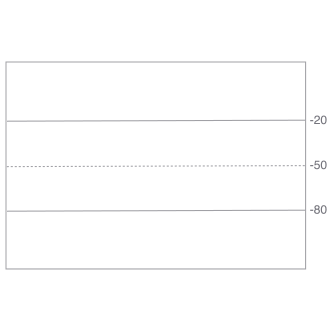Technical Events
Technical Analysis and Technical Events
Technical Analysis is the practice of anticipating changes in a financial instrument's price by finding patterns within it's price history. It is the quantitative side of investment research, and both supports and complements other views, such as Fundamental Analysis, where investors use a company's financial information such as earnings or debt to determine if it is an appropriate investment.
Coined by Equinox, a Technical Event® signifies an important pattern or activity has occurred, such as the price crossing a critical line or threshold. Technical Events highlight price situations that may be worth considering in researching an investment activity. Technical Events can be used by investors to make more informed decisions about when to:
- Enter a new position (either a long or position)
- Close an existing position
- Wait for a better time to take action
Technical Events covered
Equinox’s patented pattern recognition is paired with the industry’s largest library of technical analysis including classic patterns, candlesticks, Elliott Wave and indicators like Bollinger Bands and MACD. This allows our flagship products such as Technical Insight to analyze virtually every publicly traded financial instrument including stocks, ETFs, indices, foreign exchange and futures.
Explore the different chart patterns we cover and their implications on an instruments price below:
"Classic" is a term used to refer to a group of patterns that typically have a longer-term horizon (greater than 12 days) and which have distinct price swings such that the price swings form distinctive patterns. The names of classic patterns often reflect the shape of the formation such as the Double Top, Double Bottom, Head and Shoulders Top, Ascending Triangle and so on.

Ascending Continuation Triangle
This chart pattern shows two converging trendlines. The lower trendline is rising and the upper trendline is horizontal. This pattern occurs because the lows are moving increasingly higher but the highs are maintaining a constant price level. The pattern will have two highs and two lows, all touching the trendlines. This pattern is confirmed when the price breaks out of the triangle formation to close above the upper trendline.

Bottom Wedge / Triangle
These make up a group of patterns which have the same general shape as Symmetrical Triangles, Wedges, Ascending Triangles and Descending Triangles. The difference is that these particular formations are reversal and not continuation patterns. These patterns have two converging trendlines. The pattern will display two highs touching the upper trendline and two lows touching the lower trendline. Contrary to Triangle formations, Wedges are characterized by their boundary trendlines both moving in the same direction.

Continuation Diamond
Diamond patterns usually form over several months in very active markets. Volume will remain high during the formation of this pattern. The Continuation Diamond (Bullish) pattern forms because prices create higher highs and lower lows in a broadening pattern. Then the trading range gradually narrows after the highs peak and the lows start trending upward. The Technical Event® occurs when prices break upward out of the diamond formation to continue the prior uptrend.

Continuation Wedge
The pattern consists of two converging trend lines. The trend lines are slanted downward. Unlike the Triangles where the apex is pointed to the right, the apex of this pattern is slanted downwards at an angle. This is because prices edge steadily lower in a converging pattern i.e. there are lower highs and lower lows. A bullish signal occurs when prices break above the upper trendline. Over the weeks or months that this pattern forms the trend appears downward but the long-term range is still upward. Volume should diminish as the pattern forms.

Diamond Bottom
Diamond patterns usually form over several months in very active markets. Volume remains high during the formation of this pattern.The Diamond Bottom pattern occurs because prices create higher highs and lower lows in a broadening pattern. Then the trading range gradually narrows after the highs peak and the lows start trending upward. The Technical Event® occurs when prices break upward out of the diamond formation.

Double Bottom
Double Bottoms are considered to be among the most common of the patterns. Since, they seem to be so easy to identify, the Double Bottom should be approached with caution by the investor. It is a reversal pattern of a downward trend in a stock's price. The Double Bottom marks a downtrend in the process of becoming an uptrend. It occurs when prices form two distinct lows on a chart however, is only complete when prices rise above the high end of the point that formed the second low. The two lows will be distinct. The pattern is complete when prices rise above the highest high in the formation. The highest high is called the "confirmation point".

Flag
The pattern follows a steep or nearly vertical rise in price, and consists of two parallel trendlines that form a rectangular flag shape. The Flag can be horizontal (as though the wind is blowing it), although it often has a slight downtrend.The vertical uptrend, that precedes a Flag, may occur because of buyers' reactions to a favorable company earnings announcement, or a new product launch. The sharp price increase is sometimes referred to as the "flagpole" or "mast".

Head and Shoulders Bottom
This pattern marks a reversal of a downward trend in a financial instrument's price. An investor will be looking for increasing volumes at the point of breakout. This increased volume definitively marks the end of the pattern and the reversal of a downward trend in the price of a stock. The lows of the shoulders are definitely higher than that of the head and, in a classic formation, are often roughly equal to one another. The neckline usually points down in a Head and Shoulders Bottom, but on rare occasions can slope up. The pattern is complete when the resistance marked by the neckline is "broken". This occurs when the price of the stock, rising from the low point of the right shoulder moves up through the neckline.

Megaphone Bottom
This rare formation can be recognized by the successively higher highs and lower lows, which form after a downward move. Usually, two higher highs between three lower lows form the pattern, which is completed when prices break above the second higher high and do not fall below it. The pattern is completed when, usually on the third upswing within the pattern, prices break above the prior high but fail to fall below this level again.

Pennant
A Pennant follows a steep or nearly vertical rise in price, and consists of two converging trendlines that form a narrow, tapering flag shape. The Pennant shape generally appears as a horizontal shape, rather than one with a downtrend or uptrend. Apart from its shape, the Pennant is similar in all respects to the Flag. The Pennant is also similar to the Symmetrical Triangle or Wedge continuation patterns however; the Pennant is typically shorter in duration and flies horizontally.

Rounded Bottom
Rounded Bottoms are elongated and U-shaped, and are sometimes referred to as rounding turns, bowls or saucers. The pattern is confirmed when the price breaks out above its moving average.

Symmetrical Continuation Triangle
The pattern shows two converging trendlines, the lower one is ascending, the upper one is descending. The formation occurs because prices are reaching both lower highs and higher lows. The pattern will display two highs touching the upper (descending) trendline and two lows touching the lower (ascending) trendline. This pattern is confirmed when the price breaks out of the triangle formation to close above the upper (descending) trendline.

Triple Bottom
This pattern is composed of three sharp lows, all at about the same price level. Investors should note that the three lows tend to be sharp. While the three lows should be sharp and distinct, the highs of the pattern can appear to be rounded. The pattern is complete when prices rise above the highest high in the formation. The highest high is called the "confirmation point". The highs should be fairly rounded in shape, although it is not absolutely necessary for the validity of the pattern. The Triple Bottom is a reversal pattern and illustrates a downtrend in the process of becoming an uptrend. It is, therefore, vital to the validity of the pattern that it commence with prices moving in a downtrend.

Upside Breakout
An Upside Breakout occurs when the price of a financial instrument breaks out through the top of a trading range. This Technical Event® indicates that prices will rise explosively over a period of days or weeks as an almost vertical uptrend appears.

Continuation Diamond
Diamond patterns usually form over several months in very active markets. Volume remains high during the formation of this pattern. The Continuation Diamond (Bearish) indicates a possible continuation of a downtrend.The Continuation Diamond (Bearish) pattern occurs because prices create higher highs and lower lows in a broadening pattern. Then the trading range gradually narrows after the highs peak and the lows start trending upward. The Technical Event® occurs when prices break downward out of the diamond formation to continue the prior downtrend.

Continuation Wedge
A Continuation Wedge (Bearish) consists of two converging trend lines. The trend lines are slanted upward. Unlike the Triangles where the apex is pointed to the right, the apex of this pattern is slanted upwards at an angle. This is because prices edge steadily higher in a converging pattern i.e. there are higher highs and higher lows. A bearish signal occurs when prices break below the lower trendline. Over the weeks or months that this pattern forms the trend appears upwards but the long-term range is still downward.

Descending Continuation Triangle
A Descending Continuation Triangle features two converging trendlines. The bottom trendline is horizontal and the top trendline slopes downward. The pattern illustrates lows occurring at a constant price level, with highs moving constantly lower. The pattern displays two highs touching the upper trendline and two lows touching the lower trendline. This pattern is confirmed when the price breaks out of the triangle formation to close below the lower trendline.

Diamond Top
Diamond patterns usually form over several months in very active markets. Volume remains high during the formation of this pattern. The Diamond Top indicates a reversal to a downtrend. The Diamond Top pattern occurs because prices create higher highs and lower lows in a broadening pattern. Then the trading range gradually narrows after the highs peak and the lows start trending upward. The Technical Event® occurs when prices break downward out of the diamond formation.

Double Top
Sometimes called an "M" formation because of the pattern it creates on the chart, the Double Top is one of the most frequently seen and common of the patterns. The Double Top is a reversal pattern of an upward trend in a financial instrument's price. The Double Top marks an uptrend in the process of becoming a downtrend.A Double Top consists of two well-defined, sharp peaks at approximately the same price level. The two tops are distinct and sharp. The pattern is complete when prices decline below the lowest low in the formation. The lowest low is called the "confirmation point".

Downside Breakout
A Downside Breakout occurs when prices break out through the bottom of a trading range and descend quickly as a new downtrend forms. It appears that the market is being flooded with sell orders. There are usually gaps throughout this activity. This pattern can last for a few days to a few weeks.

Flag
A Flag (Bearish) follows a steep or nearly vertical decline in price, and consists of two parallel trendlines that form a rectangular flag shape. The Flag can be horizontal (as though the wind is blowing it), although it often has a slight upward trend. The vertical downtrend, that precedes a Flag, may occur because of buyers' reactions to an unfavorable company announcement, such as a court case, or a sudden and unexpected departure of a CEO. The sharp price decrease is sometimes referred to as the "flagpole" or "mast".

Head and Shoulders Top
This is a popular pattern among investors because it's one of the most reliable of all formations. It also appears to be an easy one to spot. Technical analysts will tell you that it is tough to spot the real occurrences. The pattern looks like a human head with shoulders on either side of the head. A perfect example of the pattern has three sharp high points. The shoulders are definitely lower than the head and, in a classic formation, are often roughly equal to one another. A key element of the pattern is the neckline and it is formed by drawing a line connecting two low price points of the formation. The neckline can be horizontal or it can slope up or down. The pattern is complete when price of the financial instrument, falling from the high point of the right shoulder, moves below the neckline.

Megaphone Top
A Megaphone Top is a relatively rare formation and is also known as a Broadening Top. Its shape is opposite to that of a Symmetrical Triangle. The pattern develops after a strong advance in prices and can last several weeks or even a few months. A Megaphone Top is formed because the prices make a series of higher highs and lower lows. The Megaphone Top usually consists of three ascending peaks and two descending troughs. The signal that the pattern is complete occurs when prices fall below the lower low.

Pennant
A Pennant (Bearish) follows a steep or nearly vertical fall in price, and consists of two converging trendlines that form a narrow, tapering flag shape. The Pennant shape generally appears as a horizontal shape, rather than one with a downtrend or uptrend. Apart from its shape, the Pennant is similar in all respects to the Flag. The Pennant is also similar to the Symmetrical Triangle or Wedge continuation patterns however; the Pennant is typically shorter in duration and flies horizontally.

Rounded Top
A Rounded Top is dome-shaped, and is sometimes referred to as an inverted bowl or a saucer top. The pattern is confirmed when the price breaks down below its moving average.

Symmetrical Continuation Triangle
A Symmetrical Continuation Triangle (Bearish) shows two converging trendlines, the lower one is ascending, the upper one is descending. The formation occurs because prices are reaching both lower highs and higher lows. The pattern will display two highs touching the upper (descending) trendline and two lows touching the lower (ascending) trendline. This pattern is confirmed when the price breaks out of the triangle formation to close below the lower (ascending) trendline.

Top Triangle - Top Wedge
Top Triangles and Top Wedges make up a group of patterns which have the same general shape as Symmetrical Triangles, Wedges, Ascending Triangles and Descending Triangles. The difference is that these formations are reversal and not continuation patterns. These patterns have two converging trendlines. The pattern will display two highs touching the upper trendline and two lows touching the lower trendline. Contrary to Triangle formations, Wedges are characterized by their boundary trendlines both moving in the same direction. This pattern is confirmed when the price breaks downward out of the Triangle or Wedge formation to close below the lower trendline.

Triple Top
A Triple Top is a reversal pattern. It marks an uptrend in the process of becoming a downtrend. The Triple Top pattern is comprised of three sharp peaks, all at the same level. While the three peaks should be sharp and distinct, the lows of the pattern can appear as rounded valleys. The pattern is complete when prices decline below the lowest low in the formation. The lowest low is also called the "confirmation point". The three peaks are well separated and are not part of a congestion pattern. The peaks do not have to be precisely at the same level.
Short-term patterns are based on the shape and relationship of the candlestick(s) or price bar(s) representing one or multiple consecutive trading days. This includes patterns such as the Hanging Man and the Gap Up. The technical event is the confirmation that the pattern has formed in the price bar(s). These Technical Event ® opportunities are useful for suggesting possible short-term price movement. They are also useful for supporting or refuting the possible price movement suggested by classic patterns. Short-term patterns are often considered as supplementary information.

Engulfing Line
The Engulfing Line occurs when the Real Body for a price bar is larger than the Real body for the previous price bar. In addition, for an Engulfing Line, the Real Body of the previous session must be Black (close lower than open) and the Real Body of the second session must be White (close higher than open).

Exhaustion Bar
Exhaustion Bars can develop after a rapid up or down move. They are a form of key reversal, but differ sufficiently enough to warrant their own category.

Gravestone
The Gravestone consists of a long Upper Shadow and no Real Body (that is the open is equal to the close for the session). There should be no Lower Shadow for a Gravestone.

Hammer
The Hammer is characterized by a small Real Body near the top of the price range. The Real Body can be black or white, although a white candlestick is preferable. A white candlestick is slightly more bullish since it shows that the market sold off sharply during the session and then rebounded to close slightly above the opening price level. The Hammer has a long Lower Shadow and an Upper Shadow that is very small or non-existent.

Inside Bar
An Inside Bar is a reversal formation characterized by a bar that forms totally within the trading range of the preceding bar. Inside Bars reflect a balance between buyers and sellers following a sharp up or down move, which is sometimes later resolved by a change in trend.

Inverted Hammer
An Inverted Hammer forms when the Upper Shadow is longer than the Real Body and the Lower Shadow is small or non-existent. The Inverted Hammer is the same candlestick shape as a Shooting Star, although the Inverted Hammer marks the end/reversal of a downtrend, whereas the Shooting Star marks the end/reversal of an uptrend.

Island Bottom
The Island Bottom occurs when the price "gaps" below a specific price range for a number of days and then is confirmed when the price "gaps" above the original range.

Key Reversal Bar
A Key Reversal Bar is one that develops after a prolonged rally or reaction. Often the trend will be accelerating by the time the price experiences the Key Reversal Bar.

Outside Bar
Outside Bars exhibit a trading range that fully encompasses that of the previous bar. They can appear after both downtrends and uptrends, and are a strong signal of trend exhaustion leading to reversal.

Two Bar Reversal
A Two Bar Reversal is a classic signal of trend exhaustion. When these patterns occur after a pronounced advance or decline, the first bar should exhibit a dramatic continuation of the inbound trend, closing close to the bar's extreme end. The second bar completely negates the first bar, with the open price on the second bar being close to the close of the first bar and the close of the second bar being close to the open of the first bar. Wider trading ranges on both bars denote a more climactic reversal in psychology.

Engulfing Line
The Engulfing Line occurs when the Real Body for a price bar is larger than the Real Body for the previous price bar. In addition, for an Engulfing Line, the Real Body of the previous session must be White (close higher than open) and the Real Body of the second session must be Black (close lower than open).

Exhaustion Bar
Exhaustion Bars can develop after a rapid up or down move. They are a form of key reversal, but differ sufficiently enough to warrant their own category.

Gravestone
The Gravestone (Bearish) consists of a long Upper Shadow and no Real Body (i.e. the open is equal to the close for the session). There should be no Lower Shadow for a Gravestone.

Hanging Man
The name "Hanging Man" is used because it has a gloomy connotation, and also because the candlestick that defines this pattern looks like a hanging man with dangling legs. The Hanging Man pattern is characterized by a small Real Body near the top of the price range. The Real Body can be black or white, although a black candlestick is preferable. A black candlestick is slightly more bearish since it shows that the close could not get back up to the opening price level. The Hanging Man has a long lower shadow that should be at least twice the length of the Real Body. The upper shadow should be very small or non-existent.

Inside Bar
An Inside Bar is a reversal formation characterized by a bar that forms totally within the trading range of the preceding bar. Inside bars reflect a balance between buyers and sellers following a sharp up or down move, which is sometimes later resolved by a change in trend.

Island Top
The Island Top occurs when the price "gaps" above a specific price range for a number of days and then is confirmed when the price "gaps" down below to the original range.

Key Reversal Bar
A Key Reversal Bar is one that develops after a prolonged rally or reaction. Often the trend will be accelerating by the time the price experiences the Key Reversal Bar.

Outside Bar
Outside Bars exhibit a trading range that fully encompasses that of the previous bar. They can appear after both downtrends and uptrends, and are a strong signal of trend exhaustion leading to reversal.

Shooting Star
A Shooting Star forms when the Upper Shadow is longer than the Real Body and the Lower Shadow is small or non-existent. The Shooting Star is the same as an Inverted Hammer, only the Shooting Star appears at the end of an uptrend, whereas the Inverted Hammer appears at the end of a downtrend.

Two Bar Reversal
A Two Bar Reversal is a classic signal of trend exhaustion. When these patterns occur after a pronounced advance or decline, the first bar should exhibit a dramatic continuation of the inbound trend, closing close to the bar's extreme end. The second bar completely negates the first bar, with the open price on the second bar being close to the close of the first bar and the close of the second bar being close to the open of the first bar. Wider trading ranges on both bars denote a more climactic reversal in psychology.

Gap Down
A Gap Down forms when the high for a period (usually a day) is lower than the previous period's low.

Gap Up
A Gap Up forms when the low for a period (usually day) is higher than the previous period's high.
Indicators that are currently supported are based on moving average calculations.

Double Moving Average Crossover
A moving average is an indicator that shows the average value of a security's price over a period of time. This type of Technical Event® occurs when a shorter and longer moving average cross each other. The supported crossovers are 21 crossing 50 (a shorter term signal) and 50 crossing 200 (a longer term signal). A bullish signal is generated when the shorter moving average crosses above the longer moving average. A bearish signal is generated when the shorter moving average crosses below the longer moving average.

Price Crosses Moving Average
A moving average is an indicator that shows the average value of a security's price over a period of time. This type of Technical Event® occurs when the price crosses a moving average. Three moving averages are supported: 21, 50 and 200 price bars. A price cross of a longer moving average indicates a longer term signal, in that the security may take a longer period of time to move in the anticipated direction. A bullish signal is generated when the security's price rises above its moving average and a bearish signal is generated when the security's price falls below its moving average.

Triple Moving Average Crossover
A moving average is an indicator that shows the average value of a security's price over a period of time. This type of event occurs when a shorter moving average crosses a medium moving average, and the medium moving average crosses a longer moving average. The moving average periods used for this event are 4, 9 and 18 day. When the 4-day crosses above/below the 9-day moving average, the event has "started". The event is "confirmed" when the 9-day moving average crosses above/below the 18-day moving average. A bullish signal is generated when the direction of the crossovers is above. A bearish signal is generated when the direction of the crossovers is below.
Oscillators are based on mathematical formulas that incorporate historical or recent prices of the stock.

Bollinger Bands
Bollinger bands are calculated based on the standard deviation of an instrument's closing price.Bollinger bands use standard deviation and a simple moving average to help traders determine buy and sell events, or to help confirm other patterns. A price chart that uses Bollinger bands displays four lines; price, the upper and lower Bollinger bands, and the moving average.

Commodity Channel Index (CCI)
Although the name CCI uses the term "commodity", the oscillator is commonly used for analyzing equities. A CCI is based on a comparison of price and moving average. The CCI is expressed as a percentage that oscillates between -100 and 100. However, these levels can be exceeded. The Commodity Channel Index quantifies the relationship between the asset's price, a 20 bar moving average (MA) of the asset's price, and the mean of the absolute deviations (D) from that average.

Fast Stochastic
The fast stochastic oscillator compares two lines called the %K and %D lines to predict the possibility of an uptrend or a downtrend. In price charts, the %K line typically appears as a solid or bold line, and the %D line appears as a dotted or softer line. The fast stochastic oscillator can be used effectively to monitor daily, weekly or monthly periods. According to Martin J. Pring, George Lane developed the stochastic oscillator with the premise that during an uptrend, the closing price tends to rise. However, when the uptrend matures, price tends to close towards the bottom of the price range for the period. Likewise, in a downtrend, the reverse holds true.

Intermediate-term KST
Price at any one time is determined by the interaction of many different time spans. Normally oscillators are constructed from a single time span so they ignore cycles not related to that specific period. The KST, on the other hand, consists of four different periods that are combined into one oscillator. Each time span used in the KST is smoothed with a moving average. Weightings are given to each moving average according to the length of the time span. Longer periods have greater weight in order to bring out a smoother curve. The KST changes direction sooner in response to price moves than similar oscillators using one time span because of the inclusion of shorter time spans.

Momentum
Momentum measures the amount that a financial instrument's price has changed over a given timeframe. Momentum is significant because it signals the strength of price trends. A healthy price trend tends to exhibit strong momentum, while weakening trends often have decreasing momentum indicating a trend reversal or correction. Momentum can also indicate short-term market extremes referred to as overbought and oversold levels. A bullish signal is generated when the Momentum rises above 0 and a bearish signal is generated when the Momentum falls below 0.

Moving Average Convergence/ Divergence (MACD)
The MACD, "Moving Average Convergence/Divergence", shows the relationship between two moving averages of prices. The MACD is the difference between a 26-day and 12-day exponential moving average. A 9-day exponential moving average called the "signal line" is plotted on top of the MACD to show bullish and bearish signal points. A bullish signal is generated when the MACD rises above the signal line. A bearish signal occurs when the MACD falls below the signal line.

Relative Strength Index (RSI)
The Relative Strength Index (RSI) is an oscillator that measures a particular financial instrument's current relative strength compared to its own price history. The RSI should not be confused with relative strength which rates a financial instrument in relation to a market such as the S&P index. The RSI is plotted on a vertical scale numbered from 0 to 100.

Slow Stochastic
The slow stochastic oscillator compares two lines called the %K and %D lines to predict the possibility of an uptrend or a downtrend. In price charts, the %K line typically appears as a solid line, and the %D line appears as a dotted line. The slow stochastic oscillator can be used effectively to monitor daily, weekly or monthly periods. According to Martin J. Pring, George Lane developed the stochastic oscillator with the premise that during an uptrend, the closing price tends to rise. However, when the uptrend matures, price tends to close towards the bottom of the price range for the period. Likewise, in a downtrend, the reverse holds true.

Williams %R
Williams %R, developed by Larry Williams, tracks the relative position of an instrument’s close price to its highest-lowest price range over a 14-bar period. %R values range from zero (higher – price is at the top of the 14-bar highest high range) to -100 (lower – price is at the bottom of the 14-bar lowest low range). The goal of the %R oscillator is to detect overbought or oversold conditions, with values in the extreme end zones of the range signaling extenuated pricing.
 English
English
 简体中文
简体中文
 Tiếng Việt
Tiếng Việt
 Malay
Malay
 Indonesia
Indonesia
 Deutsch
Deutsch
 Français
Français
 Español
Español
 Italiano
Italiano
